The 2023-2024 GS Arts & Research Collective: Building GS Culture, One Piece at a Time
As the Collective, which graces the walls of the Peter J. Awn Lounge and ARC, celebrates its third round, five GS artists share the stories behind their work.
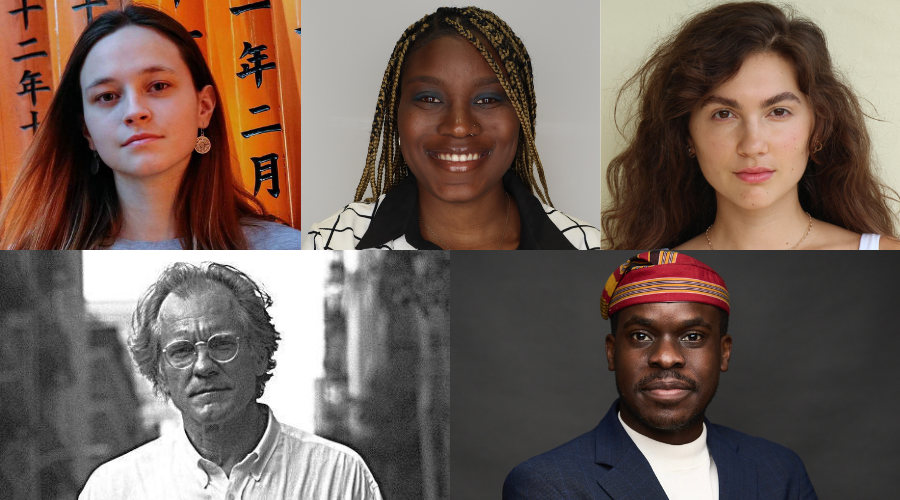
In 2021, Assistant Dean of Students Kristy Barbacane founded the GS Arts & Research Collective as a vehicle to connect the GS community through creativity. Each year, the Collective invites student submissions of visual art, music, research, creative writing, film, and more. The selected pieces are then displayed in two spaces at the heart of the GS student experience, the Peter J. Awn Student Lounge and the Academic Resource Center (ARC).
In each of its three rounds so far, the Collective has expanded the number of mediums and the range of GSers highlighted: this year’s collective welcomes the first alumni exhibitors, introduces sculpture into the medium mix, and features the largest number of submissions yet from dual degree students. The Collective will also be hosting an open house celebration for the first time ever on Thursday, September 28, from 5:30 to 7 p.m. in the Peter J. Awn Lounge.
In honor of the Collective’s third edition, and the array of diverse pieces showcased, we asked several exhibitors to share the story behind one of their submissions, from inspiration, to execution, to public presentation as part of the Collective. Together with the administrators that support the Collective, and the community viewers who engage with its art, these students and alumni are building something uniquely reflective of GS. As student participant Mikka Kabugo ‘25GS put it, “many times when we speak about people who are cultured, or societies that have culture, we refer to their art and their music. I think the Collective is going to play a big role in defining GS culture, and by participating in the Collective, I get to participate in the culture of GS.”
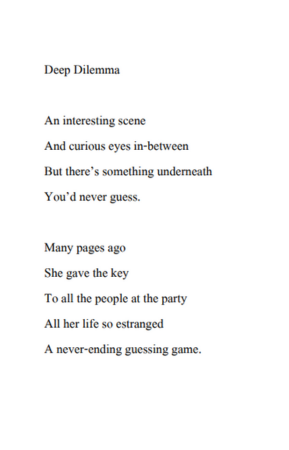
Krista Kalaj ‘24GS Undergraduate
Deep Dilemma, Poetry
“I sometimes have these phrases that come to my mind and I’ll put them in my notes, but then I don’t know how to make a cohesive or long enough piece from that to stand on its own. It’s always a challenge with me. [But with this poem] I had these little clips of ideas at night, and then I put them together.
The main idea behind it is that nothing is as it seems. You could be in a crowded area, a party or gathering, but underneath the chaos there could be something intimate with yourself that is going on that nobody in that big space knows about. I think with poems, what’s interesting is you can break apart different experiences you’ve had, why you reacted a certain way. It really helps you understand yourself a little bit better. That’s honestly, if I could encapsulate why I write poems, it's because it helps me understand myself better in a world where there's just so much chaos.”

Keisha Jackson ‘25GS Undergraduate
Wear-able Book, Sculpture
"My piece is an architectural project called the wearable book. It is inspired by my love for reading and psychology. I wanted to create a piece that can be read from any angle and it is meant to depict the way we read people when we see them for the first time. I hope the audience is able to consider the ways that they read/ perceive others and the ways they are also perceived within any given space."
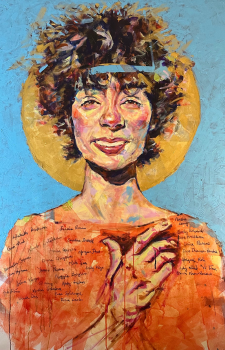
Mikka Kabugo ‘25GS Undergraduate
The Extent of My Soul, Acrylic on canvas
“It’s a six foot by four painting, exactly my height when I stand next to it. And it was done because I was approached by someone in GS. I initially was skeptical about doing it because of my experiences outside Columbia doing artwork, making commissions, and either having galleries or individuals or whatever person commissioned just trying to be sneaky about the way they acquire the work. And I was a bit skeptical but I just felt that [making the piece] would allow me to connect more with the community here and actually have something that I've done while being here that's very reflective of the interactions I have had with people here. So that piece is very important to me in that regard.
It was part of a Columbia production of In the Heights [at Lerner]. The actress I painted plays the abuela, someone who is giving and loved in the community. I was tasked with creating something that represented that. When I did the work, it wasn't for any other thing but to be a part of the community work, something that people would look at and think about the show in Lerner, think about the names that are inscribed as part of the pattern in her shirt [names of the production’s crew], the act of giving, the fact that there’s a lot of religious tropes around it, the halo, the Columbia blue in the background. There was a lot of thought that went into it. I put it into the Collective because really, fundamentally, I made it because I wanted it to be a part of the Columbia and GS community.
The process of making it was insane. I didn’t have the tools at the time to put the canvas together myself, so I carried it already on the frame across New York, on the subway, before I even painted it. The draft of the wind that hits the canvas as you carry it on the street: insane! Then I had to carry it up five floors, because I live on the fifth floor. When it was done, I had to carry it from my house to campus, and after the production, I took it to the Academic Resource Center [for the Collective]. Now it’s back in the Lounge. So, besides the pain of moving it around, it’s kind of interesting how it came full circle. The very initiation of making it, the commissioning, happened in the Lounge. And from that room, it traveled all around and ended up back in the Lounge for the first time to be displayed to the general public.”
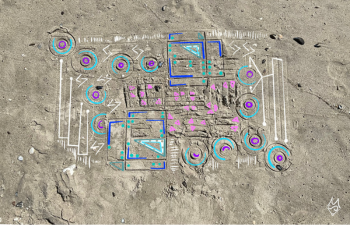
Senia Magzumov ‘24GS Undergraduate Dual BA with Trinity College Dublin
Geometry of Nature “Machine”, Mixed media collage
“I learned about the Collective through the GS email list, however, it was a good friend of mine who urged me to participate in the Collective. I have so far mostly exhibited in art class or school settings—so for me, this was a big step to apply for my art to be shared with an audience without representing a specific visual art class—but rather as an individual.
One of my works, “Geometry of Nature ‘Machine,’" explores the concept of printmaking in nature and interlaces the experience of perception of nature through digital art by tracing and creating a narrative. The photograph was taken on Rockaway Beach where I created prints with various objects (such as CD disks and plastic cups). After digitizing the print, I created a digital art layer with my drawings as a collage through the Procreate program. I chose to submit this work as it demonstrates my artistic practice of mixing mediums to create one singular work. I hope that the audience, through this art piece, can experience and question their own perception of nature, its function and its role in the 21st century of the digitally inclined world— while also exploring the concept of art with an awareness of the material of its making.”
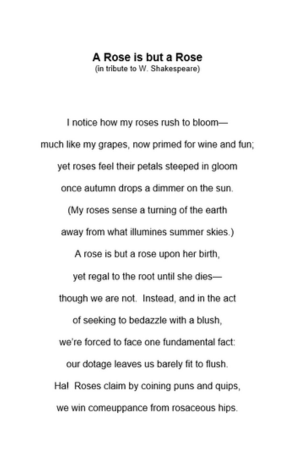
Russell Bittner ‘84GS Alumnus
A Rose is but a Rose, Poetry
"I found out about Collective quite by accident, but I’m certainly happy I did. My motivation to participate? Quite simple, really: I’d still like to publish something that might win me some minor recognition before I become just a breath of old wind.
“A Rose is but a Rose” is, first and foremost, a sonnet. It doesn’t get much more formal in formal poetry than a sonnet—whether English, Elizabethan, or Shakespearean (as is this one), Petrarchan or Spenserian. Common to all sonnet forms is the line count: 14. And common, too, is an end rhyme scheme, the precise model of which varies according to the poet’s choice of sonnet form. In the case of a Shakespearean sonnet, the end rhyme scheme is characterized by the rhyming of the last two lines of the concluding sextet (abab cdcd efef gg). And finally—and most difficult—the meter. I’ve written this piece in iambic pentameter. This metrical choice allows for five feet (or 10 syllables) in each of the 14 lines. In iambic meter, the second syllable (syllables 2, 4, 6, 8 and 10) is stressed, while the first syllable (1, 3, 5, 7, 9) remains unstressed. A minor exception—specific to a Shakespearean sonnet and as noted above—remains the last two lines, both of which rhyme with one another.
Are rhyme schemes in sonnets restricted to end rhymes alone? Nonsense! I’ve done my own best to imitate Shakespeare in his use of alliteration and assonance. Moreover, I’ve attempted, however less than well, to imitate Shakespeare in what Shakespeare the poet is perhaps best known for: his employment of puns. This is always a risk, but I thought it worth taking.
This Shakespearean sonnet contains, therefore, not only a pun leading up to its resolution, but also an epanalepsis reinforcing the opening lines with the concluding lines describing the scantily clad authoress of a particularly significant Biblical event. We have come to know this event (and its tragic aftermath) as the Dance of the Seven Veils or the Dance of Salome. I can only hope that I have accomplished all of the above satisfactorily. Truth is, the labor here required two years of traveling first throughout Brooklyn, neighborhood by neighborhood, then throughout Manhattan on the same mission. The travel and neighborhood study were the course of my job searching for residential construction of new kitchens. If I cheated at all here it was in allowing kitchen construction to stand in for the creation of a rose garden in completion of a dream, of a house, and of a dreamhouse. Yet, I managed to write two poems to roses—the closest thing to divinity here on earth—and for what it’s worth (if anything to anyone), those poems will remain on the walls of my children’s bedrooms as a reminder of the eager gardener their father once was."
